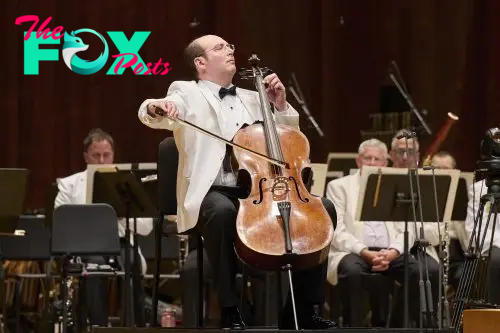Entertainment
Mark Kosower’s Walton Cello Concerto steals the present at Cleveland’s Blossom Pageant – Seen and Heard Worldwide
 United States Blossom Pageant 2024 [4]: Mark Kosower (cello), Cleveland Orchestra / Hannu Lintu (conductor). Blossom Music Heart, Cuyahoga Falls, 27.7.2024. (MSJ)
United States Blossom Pageant 2024 [4]: Mark Kosower (cello), Cleveland Orchestra / Hannu Lintu (conductor). Blossom Music Heart, Cuyahoga Falls, 27.7.2024. (MSJ)

Sibelius – ‘Lemminkäinen’s Return’ from 4 Legends of the Kalevala, Op.22
Walton – Cello Concerto
Shostakovich – Symphony No.5 in D minor, Op.47
Pre-concert function: Kent/Blossom Chamber Orchestra / Daniel Reith (conductor)
Beethoven – Symphony No.2 in D main, Op.36
It’s not simple to steal the present from a heavy-hitter like Shostakovich’s Fifth, particularly with a largely introspective and dreamy piece. However kudos to the Cleveland Orchestra’s principal cellist, Mark Kosower, for doing so. A lot much less typically heard than the Shostakovich, the cello concerto by English composer Sir William Walton is nonetheless an intoxicating swirl of kaleidoscopic colours and moody longings, paying homage to the ambivalence of the identical composer’s early Viola Concerto, however with a higher sense of colour and sensuality.
Kosower leaned into the non-public really feel of the solo half, making it sing and sigh beneath the flecks of colour in Walton’s orchestration, delivered with a certain hand by visitor conductor Hannu Lintu. They joined collectively for sparks and mischief within the virtuosic Allegro appassionato second motion, essentially the most extroverted a part of the work. Then, because the finale started, a kind of magical moments occurred that may solely happen at an outside pageant. Someplace deep within the woods on the north facet of the pavilion, a dove started singing. Its falling name fitted in with the sweetly melancholy cello half prefer it was meant to be. Kosower was so deep contained in the music, he was unfazed, passing into the ardent cadenza which follows with a sense of inevitability. When the piece ended, utilizing the usual model of the work, not the loud alternate ending, it trailed off into a wide ranging silence that remained unbroken for a lot of seconds.
Kosower is at all times a compelling soloist, however this efficiency was a deft combination of moody brilliance and lyrical longing, and so compelling that it’ll stand in reminiscence for a very long time. The cellist appeared stunned by the iNFLuence he had. He tried at one level in the course of the ovation to get his colleagues within the orchestra to face and be part of him in accepting the applause, however they refused to take action, acknowledging that the second was for him alone. Then he appeared much more stunned when Lintu pushed him again to middle stage to do an encore in response to the prolonged applause. It’s not typically {that a} quiet and dreamy piece attracts an encore, nevertheless it did right here, and Kosower responded with a thoughtfully elegant efficiency of a motion from certainly one of Bach’s solo suites.
The live performance was began with alacrity by Lintu striding on stage with full confidence and launching right into a crisp and compelling efficiency of ‘Lemminkäinen’s Return’ from the 4 Legends of the Kalevala suite. Accents and syncopations had been delivered with what can solely be described as mastery. It makes one lengthy to listen to Lintu within the full Legends, which hasn’t been performed in full for fairly some time in Cleveland. The conductor’s assured swagger pushed ahead in locations, launched pressure in others, and introduced it to a roaring shut.
I want the conductor had introduced the identical swaggering certainty to Shostakovich’s Symphony No.5, however the efficiency was just a little on the subdued and dour facet although nonetheless highly effective. Lintu’s management tended to form the piece in lengthy stretches of 1 steady tempo, whereas the composer’s rating suggests much more ebb and circulation. The least efficient stretch was the primary half of the finale. Like all too many conductors, Lintu began it at a reasonable velocity, shortly shifted to a reasonably quick tempo, after which stored that till the massive implosion in the course of the motion. That isn’t what Shostakovich requested for, although. What he truly wrote was for that first tempo adjustment to extend the velocity some, however not quite a bit. Then, every succeeding paragraph of the music is designated to hurry up one other notch, a stairstep impact by ever-increasing tempos, leading to a hysterically quick sprint by the center of the motion which fuels the implosion. With out that motivation, what precisely is the purpose of stated implosion?
Lintu’s method appeared an try to reduce the political and biographical particulars that swarm across the work, giving it a agency, classical form. Even his supply of the notorious closing pages was restrained. This system observe by commentator Peter Laki was in the identical spirit, disingenuously describing the closing pages because the second the melody ‘immediately alights on a shiny D main chord in full orchestral splendor – remaining unchanged for greater than a minute to finish the symphony’.
I’m sorry, however this ending just isn’t actually that ambivalent, particularly contemplating that we now know that the motion’s theme quotes a tune Shostakovich had written, however stored hidden, which talks about how barbarians suppress the works of artists. It’s an apparent reference to Soviet premier Josef Stalin denouncing Shostakovich and almost ending his profession. Shostakovich rigorously wrote his Fifth to placate the authorities by pulling again from the experimental fringe of his earlier works, however he made certain to bury issues within the music that inform the true story. I’m not saying Shostakovich was some heroic dissident, for he compromised himself many instances by taking awards and commissions from the Soviets. However it’s evidently true that he buried subversive meanings in a lot of his works and ignoring them or pretending they don’t exist does the works no justice. And in an age the place many highly effective forces attempt to steamroll over something they don’t wish to hear, isn’t it necessary to sear them with the reality?
I don’t imply this to sound like a pan of Lintu’s efficiency as he’s a extremely expert and warranted conductor. His Sibelius proved that he can set music on hearth if he so needs. That’s the reason his grim method to the Shostakovich was just a little disappointing, when it could possibly actually deal with the identical flame. The efficiency was stable however on no account approached the searing scorch of Jakub Hrůsa’s interpretation with the orchestra in 2018, assessment right here.
The Cleveland Orchestra was in positive type all through and was joined within the Shostakovich by members of the Kent/Blossom Chamber Orchestra, an orchestral coaching and mentorship program that runs within the summers, giving music college students a possibility to work with members of the Cleveland Orchestra. Since its founding, this system has labored with over 2500 younger musicians, sixteen of whom have gone on to affix the Cleveland Orchestra. Within the Shostakovich, there’s a lot to be stated for having seven horns and 5 flutes, for it deepened and enriched the orchestral palette. Earlier than the primary occasion, a pre-concert by the KBCO delivered an alert efficiency of Beethoven’s Symphony No.2, performed with good consideration to element by Cleveland Orchestra affiliate conductor Daniel Reith.
Mark Sebastian Jordan
-

 Entertainment42m ago
Entertainment42m agoNatasha Rothwell on Her Memorable Firsts
-

 Entertainment6h ago
Entertainment6h agoFace Me and Other Korean Medical Crime Shows That are Must Watch
-

 Entertainment11h ago
Entertainment11h agoClassic Korean Movies Like Piagol to Add to Your Watch List
-

 Entertainment11h ago
Entertainment11h agoOver 60 Million People Tuned in to Watch Jake Paul vs. Mike Tyson
-

 Entertainment18h ago
Entertainment18h agoPopular Hudson Valley Italian Restaurant Addresses Closing Rumors
-

 Entertainment19h ago
Entertainment19h agoRHOBH’s Dorit Kemsley Addresses Viral Smoking Scene on Season 14 Premiere: ‘I Was Being Chased’
-

 Entertainment23h ago
Entertainment23h agoThe 10 Best Podcasts of 2024
-

 Entertainment1d ago
Entertainment1d ago‘RHOBH’ Star Dorit Kemsley Opens Up About Crumbling Marriage to PK: ‘Agreed to Separate’



























